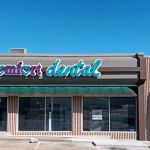The Signs and Treatment for a Receding Gum Line: Understanding and Addressing Gum Recession
A receding gum line, also known as gum recession, is a dental issue that affects millions of people worldwide. It occurs when the gum tissue surrounding the teeth pulls back, exposing more of the tooth or its root. Gum recession can lead to several complications, including increased tooth sensitivity, a higher risk of decay, and even tooth loss if left untreated. In this article, we will explore the signs of a receding gum line, the causes behind it, and the various treatment options available to prevent further damage and restore your oral health.
1. What is a Receding Gum Line?
Gum recession is a gradual process that happens when the gum tissue around the teeth shrinks, revealing the roots of the teeth. This is a common condition that can affect individuals of all ages but is more prevalent in older adults. While some gum recession is natural with age, it can also be caused by several factors such as poor oral hygiene, aggressive brushing, smoking, or underlying dental issues.
In a healthy mouth, gums should tightly cover the teeth and their roots. However, as gums recede, they expose more of the tooth surface, and in some cases, the tooth’s root, making it more vulnerable to bacteria and decay. The visible signs of a receding gum line can include tooth sensitivity, longer-looking teeth, and an increased risk of gum disease.
2. Common Signs of a Receding Gum Line
Identifying the signs of a receding gum line early is key to preventing further damage. Here are some common symptoms to watch for:
- Tooth Sensitivity: One of the first signs of a receding gum line is increased tooth sensitivity. As the gums pull away from the teeth, they expose the sensitive root surface, making you more vulnerable to discomfort when consuming hot, cold, sweet, or acidic foods.
- Longer Teeth: If you notice that your teeth appear longer or that your teeth look uneven, it may be a sign of gum recession. This is because the roots of the teeth are becoming exposed as the gum tissue retracts.
- Gum Bleeding: When brushing or flossing, if your gums bleed easily, it could indicate inflammation due to gum recession. Bleeding gums are also a symptom of gum disease, which is often a contributing factor to recession.
- Bad Breath or Taste: As gums recede and pockets form between the teeth and gums, food particles and bacteria can accumulate, leading to persistent bad breath or an unpleasant taste in the mouth.
- Visible Roots: In more advanced stages of gum recession, you may begin to see the roots of your teeth exposed, which can lead to further complications like tooth decay and infection.
3. Causes of Gum Recession
There are several causes of a receding gum line, many of which are preventable with proper oral hygiene practices. The most common causes include:
- Poor Oral Hygiene: Not brushing or flossing properly can lead to plaque buildup, which eventually leads to gum disease. Plaque can irritate the gum line and cause the gums to pull away from the teeth.
- Brushing Too Hard: While brushing is essential for maintaining oral hygiene, brushing too aggressively can damage the gums and cause them to recede. It is important to use a soft-bristled toothbrush and gentle pressure.
- Genetics: Some individuals are genetically predisposed to have thinner gums or a greater risk of developing gum recession. Family history plays a significant role in your risk for gum problems.
- Hormonal Changes: Hormonal fluctuations, particularly during pregnancy, menopause, or puberty, can make the gums more vulnerable to recession and other dental issues.
- Smoking: Smoking and tobacco use can negatively affect your gums, leading to weakened gum tissue and increased plaque buildup.
- Grinding Teeth: Habitual teeth grinding, or bruxism, can put excessive pressure on the teeth and gums, leading to gum recession over time.
4. Treatment Options for a Receding Gum Line
If you notice signs of a receding gum line, it’s essential to take action before the condition worsens. There are various treatment options available to help prevent further recession and restore gum health:
- Deep Cleaning: The first step in treating gum recession often involves a professional cleaning. A dentist or hygienist will perform a deep cleaning to remove plaque and tartar buildup from beneath the gum line, which helps reduce inflammation and promotes healing.
- Scaling and Root Planing: If gum disease is contributing to the recession, a scaling and root planing procedure may be necessary. This treatment involves removing tartar from the tooth roots and smoothing the roots to help the gums reattach to the teeth.
- Gum Grafting: In cases of advanced gum recession, a gum graft may be required. This procedure involves taking tissue from another part of your mouth (or using a donor graft) to cover the exposed tooth roots. Gum grafting can help restore the gum line and prevent further recession.
- Lasers: Laser therapy is a minimally invasive treatment option that can be used to remove damaged tissue and stimulate gum tissue regeneration. Lasers may also help reduce the discomfort and swelling associated with gum recession.
- Improved Oral Hygiene: One of the most important aspects of treating a receding gum line is maintaining proper oral hygiene. Brushing with a soft toothbrush, flossing daily, and using antimicrobial mouthwash can help prevent further gum recession and improve gum health.
5. How to Prevent a Receding Gum Line
Preventing a receding gum line is much easier than treating it once it occurs. By following a few simple steps, you can reduce your risk and maintain healthy gums for years to come:
- Brush Gently: Use a soft-bristled toothbrush and brush gently in circular motions. Avoid aggressive brushing, as it can damage your gums.
- Floss Regularly: Flossing helps remove plaque and debris from between your teeth and along the gum line, preventing gum disease and recession.
- Use a Mouthwash: An antimicrobial mouthwash can help kill bacteria and prevent plaque buildup around the gum line.
- Quit Smoking: Smoking impairs gum health and can contribute to gum recession. Quitting smoking will improve your overall gum health.
- Visit Your Dentist Regularly: Regular dental check-ups are essential for detecting gum recession early and preventing it from worsening.
Conclusion: Taking Action to Preserve Your Gum Health
Gum recession is a serious dental issue that can lead to long-term oral health problems if not addressed. However, by recognizing the signs of a receding gum line early and seeking appropriate treatment, you can restore your gum health and prevent further complications. Whether through professional treatments like scaling and root planing, or simple lifestyle changes like improved oral hygiene, there are effective ways to manage and prevent gum recession.
If you're concerned about a receding gum line or want more information on treatment options, visit Dentistry Toothtruth for expert advice and resources on how to care for your gums.







 Comfort Dental South Independence – Your Trusted Dentist in Independence4.0 (334 review)
Comfort Dental South Independence – Your Trusted Dentist in Independence4.0 (334 review) Chaska Family Dental4.0 (266 review)
Chaska Family Dental4.0 (266 review) Gentle Family Dentistry5.0 (60 review)
Gentle Family Dentistry5.0 (60 review) Tend East Nashville4.0 (319 review)
Tend East Nashville4.0 (319 review) Riverside Family Dental4.0 (431 review)
Riverside Family Dental4.0 (431 review) Second Street Dental4.0 (423 review)
Second Street Dental4.0 (423 review) The Importance of Oral Health Education During Pregnancy for a Healthy Pregnancy
The Importance of Oral Health Education During Pregnancy for a Healthy Pregnancy Best Tips for Brushing Your Teeth Properly for Healthy Gums: Essential Techniques for Oral Health
Best Tips for Brushing Your Teeth Properly for Healthy Gums: Essential Techniques for Oral Health Why Skipping Dental Checkups Can Lead to Bigger Oral Health Problems
Why Skipping Dental Checkups Can Lead to Bigger Oral Health Problems Advantages of Porcelain Dental Restorations
Advantages of Porcelain Dental Restorations How Can Diabetes Cause Tooth and Gum Problems? Preventing and Managing Oral Health Issues
How Can Diabetes Cause Tooth and Gum Problems? Preventing and Managing Oral Health Issues Healthy Habits for Promoting Good Oral Health and Hygiene: Tips for a Healthy Smile
Healthy Habits for Promoting Good Oral Health and Hygiene: Tips for a Healthy Smile